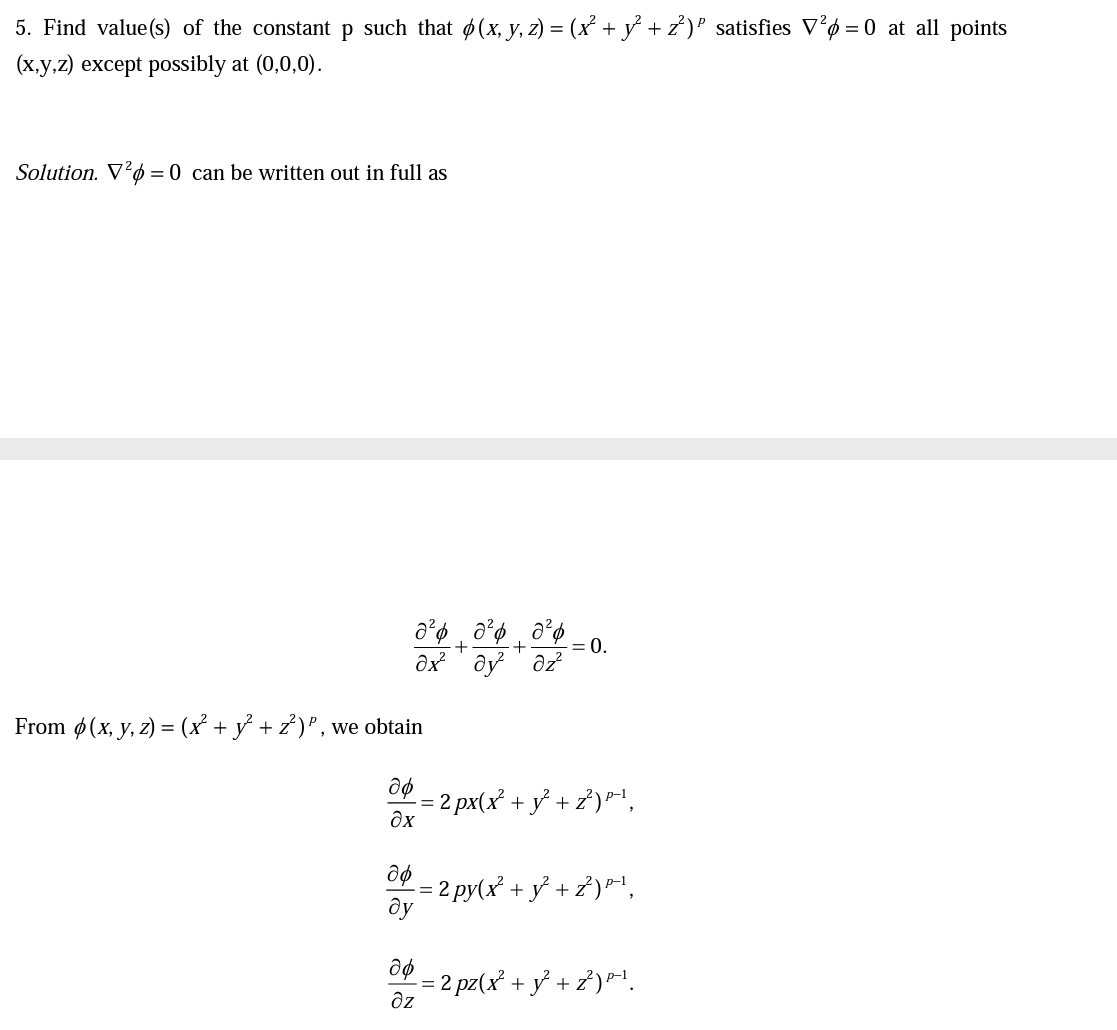and = 4 p(p- 1)x² (x² + y+²)*² +2 p(x² + y° +2)P!, -= 4 p(p-1) y (x + ỷ +z')*² +2 p(x² + yỷ + ?)®, = 4 p(p-1) z² (x² + y² + z²)? +2 p(x° + y° + *). Thus, V²ø = 0 gives 4p(p-1)x (x + у+7)2 +2 p(x? + ў +7) +4 p(p-1) y (x + y + 2)*² +2 p(x² + y + ?)*1 +4 p(p-1)z (x + y + 2)"?+2 p(x + ỷ + р-2 = 0 Which can simplified to [4 p(p-1) + 6 p](x² + y} + z)* = = 0. The above equation is true for x, y and z (except possibly at (0,0,0)) if the constant p is selected such that 4 p(p-1) + 6 p= 0= p(4 p+ 2) = 0= p=0, p=-1/2.
and = 4 p(p- 1)x² (x² + y+²)*² +2 p(x² + y° +2)P!, -= 4 p(p-1) y (x + ỷ +z')*² +2 p(x² + yỷ + ?)®, = 4 p(p-1) z² (x² + y² + z²)? +2 p(x° + y° + *). Thus, V²ø = 0 gives 4p(p-1)x (x + у+7)2 +2 p(x? + ў +7) +4 p(p-1) y (x + y + 2)*² +2 p(x² + y + ?)*1 +4 p(p-1)z (x + y + 2)"?+2 p(x + ỷ + р-2 = 0 Which can simplified to [4 p(p-1) + 6 p](x² + y} + z)* = = 0. The above equation is true for x, y and z (except possibly at (0,0,0)) if the constant p is selected such that 4 p(p-1) + 6 p= 0= p(4 p+ 2) = 0= p=0, p=-1/2.
Algebra & Trigonometry with Analytic Geometry
13th Edition
ISBN:9781133382119
Author:Swokowski
Publisher:Swokowski
Chapter10: Sequences, Series, And Probability
Section: Chapter Questions
Problem 49RE
Related questions
Question
hello, i am unable to understand this question even though i have the working solution, please advice me step by step. i dont even understand how did the first equation get formed, is there some formula ?
* =
= 0.
The above equation is true for x, y and z (except possibly at (0,0,0)) if the constant p is selected such that
4 p(p-1) + 6 p= 0= p(4 p+ 2) = 0= p=0, p=-1/2.](/v2/_next/image?url=https%3A%2F%2Fcontent.bartleby.com%2Fqna-images%2Fquestion%2Ffe594dc0-2b5b-4bcb-9d92-f82cc2a5b645%2F82ab00b7-b1b5-4751-b02b-c3e5388edf0c%2Fn0oeci_processed.png&w=3840&q=75)
Transcribed Image Text:and
= 4 p(p- 1)x² (x² + y+²)*² +2 p(x² + y° +2)P!,
-= 4 p(p-1) y (x + ỷ +z')*² +2 p(x² + yỷ + ?)®,
= 4 p(p-1) z² (x² + y² + z²)? +2 p(x° + y° + *).
Thus, V²ø = 0 gives
4p(p-1)x (x + у+7)2 +2 p(x? + ў +7)
+4 p(p-1) y (x + y + 2)*² +2 p(x² + y + ?)*1
+4 p(p-1)z (x + y + 2)"?+2 p(x + ỷ +
р-2
= 0
Which can simplified to
[4 p(p-1) + 6 p](x² + y} + z)* =
= 0.
The above equation is true for x, y and z (except possibly at (0,0,0)) if the constant p is selected such that
4 p(p-1) + 6 p= 0= p(4 p+ 2) = 0= p=0, p=-1/2.

Transcribed Image Text:5. Find value(s) of the constant p such that ø(x, y, z) = (x + y + z)' satisfies Vø = 0 at all points
(х,у,2) еxcept possibly at (0,0,0).
Solution. V'ø = 0 can be written out in full as
= 0.
From ø (x, y, z) = (x² + y + z)®, we obtain
= 2 px(x + y + z)P!,
Əx
= 2 py(x + y + z)*,
ду
2 pz(x² + y} + z)P.
Expert Solution
This question has been solved!
Explore an expertly crafted, step-by-step solution for a thorough understanding of key concepts.
Step by step
Solved in 2 steps with 2 images

Recommended textbooks for you

Algebra & Trigonometry with Analytic Geometry
Algebra
ISBN:
9781133382119
Author:
Swokowski
Publisher:
Cengage

Algebra & Trigonometry with Analytic Geometry
Algebra
ISBN:
9781133382119
Author:
Swokowski
Publisher:
Cengage